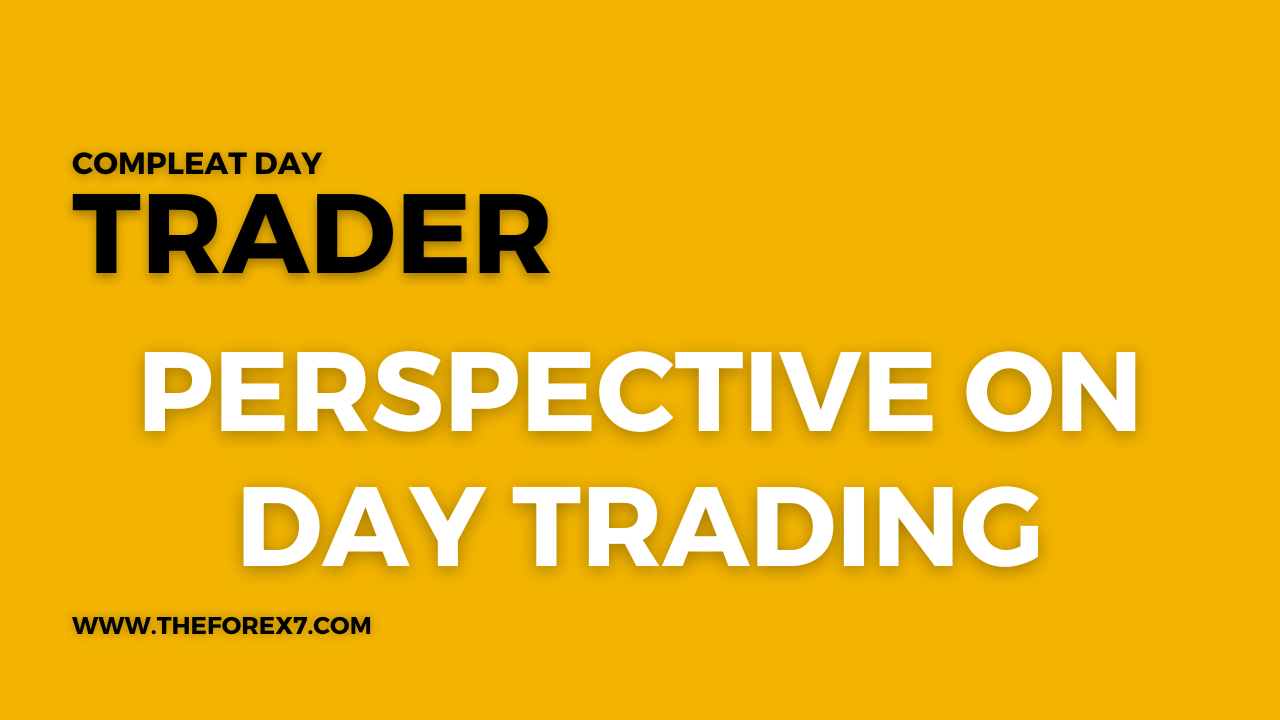The Day Trader’s Rules for Success
Price Data, Major Events or News, Inactive Markets, Market Myths
Course: [ THE COMPLEAT DAY TRADER II : The Compleat Day Trader ]

Day traders are no different in their unwillingness to follow rules than are most traders. The good news is that if the day trader fails to follow the rules of successful trading, his or her end will come swiftly and decisively.
The Day Trader’s Rules for Success
"I had an aunt in Yucatan
Who bought a python from a man
And kept it for a pet
She died, because she never knew
These simple little rules and few
The snake is living yet."
-HILAIRE BELLOC
Day traders are no different in their
unwillingness to follow rules than are most traders. The good news is that if
the day trader fails to follow the rules of successful trading, his or her end
will come swiftly and decisively. The consequences will be quick and the lesson
will be a definitive one. There will be very little waiting or wondering. Why
is this good news? I say it's good news because when you break the rules of
profitable day trading you'll get your feedback promptly. And this will give
you an opportunity to change and to learn, provided you want to. The position
trader, on the other hand, may often need to wait many weeks or even months
before he or she realizes that a faux pas has been committed. And this will
slow the learning process significantly.
It is impossible for me to overemphasize the
fact that consistently profitable traders, and in particular, consistently
profitable day traders, are great because they have mastered the discipline of
trading as well as the necessary and reliable mechanical aspects of day
trading. Throughout this book I have emphasized the great importance of
self-discipline as a trader. Clearly, the weakest link in the chain of trading
is the trader. There can be no consistent success without a mastery of self and
self-discipline. There are many opinions as to what constitutes discipline. And
there are many different opinions as to how one may undertake the often arduous
and self-effacing task of acquiring self-discipline.
Different traders, different writers, and
different behavioral analysts will give
you distinctly different opinions, all based in part on their observations and
experiences. But take care if you heed any advice you are given by someone who
has never traded. Unless the individual who is giving you assistance is a
professional psychologist, counsellor, or behavioral therapist, take all points
of view and all directions of assistance with a few grains of salt.
Know that the following suggestions and
observations have been tempered and shaped by nearly 30 years of trading,
market analysis, research, and observation. My trading has exposed me to every
conceivable type of market and every conceivable type of news event. My trading
has taken me to the highest of emotional highs and the lowest of emotional
lows. I have been on all sides of the trading fence. I have broken practically
every rule in the book, and I have even broken rules that were not in the book.
My own losses and failures have forced me to develop an arsenal of time- tested
methods, attitudes, opinions, and procedures, which I now share with you. The
best way for me to convey this information is by listing, not necessarily in
order of importance, what I have discovered.
Determine Your Orientation—Know Your Direction
One of the most important things a day trader
can do is to arrive at a comfortable and confident place in terms of system,
method, procedure, and orientation. It is important for the trader to find his
or her place in the ever-growing world of day-trading possibilities. What
markets should you trade? What systems or indicators should you use? What
quotation system or data feed should you use? How often should you trade?
Should you be a "scalper" or
should you take things more slowly? Should you give up your job to trade
full-time or should you wait and take things slowly?
There are many things a day trader can do,
but only a limited number of them can be done at the same time. Using the
information presented in this book and in The Compleat Day Trader, find one or
several techniques that make sense to you. Try them out on paper or on a modest
basis in real time until you feel confident with them. These will be the
techniques you should use in your trading.
Once you have chosen your methods, use them
consistently, day in and day out, whenever you have a signal or a trade. Make a
commitment to trade the signals strictly by the rules for a certain amount of
time, for a given number of trades, or for a given amount of risk capital.
You will find that certain techniques work
best in certain markets: S&P futures, for example, are especially well
suited to the many of the systems I have described earlier. However, you may
not feel comfortable with S&P futures. T-bond futures are particularly well
suited to the support and resistance, scalping-type methods I have discussed.
Currency futures, given their sharp and fairly quick moves, are especially well
suited to hit-and-run trading methods and/or to some of the spread indicators
contained in this book. The gap methods I have presented herein also work well
in currencies but with some variation on the theme. Determine which approaches
suit you best and devote your time to those methods consistently and for a
reasonable period. Find your place and rest in it for a while. Learn from your
mistakes and from your visceral and emotional reactions. Make every loss count.
Losses are your tuition.
Don’t Be Surprised If You Lose Money at First—Some People May Never Succeed
Many traders are disappointed and frustrated
when immediate success in day trading isn't forthcoming. I urge you to
persevere. Be persistent in giving yourself sufficient time to achieve success.
We know from our evaluation of trading systems and methods that even the best
system can lose money 7 or 8 or even 10 times in a row. It is the nature of the
trading beast to bite you a few times before you show a profit.
Learning day trading from a book is like
learning how to ride a bicycle by reading a book. Once you try to do it on your
own, you have to be prepared for a few falls. But with care, precautions, and
consistency you'll avoid breaking your neck when you fall.
Even if you have more than a slight amount of
experience in position trading, you may still find yourself initially losing as
a day trader. Although you may feel that your position-trading experience will
serve you well, it may actually prove detrimental, since you have approached
day trading with preconceived notions that may stand in your way, clouding
issues and confounding your thinking. You will need to abandon these
dysfunctional ideas in favor of those that I have offered in this book, if what
I've said makes sense to you. Remember that this process takes time. Some
failures at first are unavoidable. You will need to fall off the bicycle a few
times before you can ride it. At first your riding will be shaky and slow.
After a while, however, you will feel at home on the day-trading bicycle, and
it will take you where you choose to go, provided you follow a smooth road.
How long will it take you to become a
successful day trader? There is no answer other than perhaps more than 2 weeks
and less than 2 years, perhaps never; however, these are certainly not hard-and-fast
rules. Some of you will become successful day traders in several weeks, whereas
others will never achieve consistent success.
There are too many books on positive mental
attitude that tell you to have great expectations. They tell you to visualize
success. They encourage you to engage in affirmations. They push you to see
yourself as a highly profitable trader or investor. I take issue with all of
these books, and I caution you against having unrealistic expectations. Try not
to have great expectations. Expect to lose. Expect that with time you should
begin to break even. Expect that with more time and with more experience you
will begin to show profitable results.
Do not expect profits at first. Rather,
expect that learning the game will cost you tuition both in terms of time and
money. Therefore, you must understand the reasons for your every loss and you
must learn from them. There are hundreds if not thou-sands of traders who begin
their trading with unrealistic expectations, a few thousand dollars in risk capital,
and a total lack of discipline or method. They soon leave the markets beaten,
broke, and broken. In the meantime, their money has been gobbled up by
professional traders who thrive on the losses of tyros. If you have any
expectation, then expect failure while hoping that through your learning
experiences you can minimize the failures and maximize the successes.
Shut Out the Input of Others—Play Your Game by Your Own Rules
Should you allow yourself to be exposed to,
pandered to, and intimately influenced by the many fantastic claims for perfect
trading systems and "Holy Grail" seminars,
then you will be diverted on your road to success. There is nothing wrong with
attempting to improve on what you are doing, but the act of endless searching
will distract you from your goal. Don't get side tracked on your journey. If
you are confident with your trading methods and rules, then use them and profit
by them. Persevere and ignore the claims and opinions of others as much as you
can.
Those who purport to have better systems,
better methods, fool-proof indicators, outstanding results, and fail-safe risk
management will constantly barrage traders with their claims. Before you give
any of these serious attention, make sure that what you're doing is not better.
Every system you test, every seminar you attend, every piece of software you
buy, and every path you take may prove to be a costly excursion away from your
final destination. Each takes time, effort, and money. And these are the most
precious commodities in the world. They are limited resources not easily
replaced.
Therefore, I suggest you find a methodology
and commit to it for a predetermined length of time. And during this period of
time do not allow yourself to become distracted by anything else, even if it
means that you need to close your eyes and ears to the magazines, newspapers,
and mail you receive.
Take Your Losses When Your Signals So Dictate—Don’t Make Excuses!
Riding losses is the worst thing a trader can
do. Not taking a loss when you should take the loss is the worst thing you
could do. I have stated repeatedly throughout this book that the single worst
offense a day trader can commit is to carry a position beyond the end of the
trading day, particularly if it is a losing trade. At times a profitable trade
carried overnight may become even more profitable on the next opening. This
issue has already been discussed objectively as the FPO exit (first profitable
opening) and the nth profitable exit. But a losing trade usually gets worse if
not closed out. If you fail to exit a trade at the end of the day, then you are
violating the essence of day trading and you therefore risk exposure to
everything that a day trader seeks to avoid. Do not, under any circumstances
violate this cardinal rule regardless of what the excuse or excuses may be.
But what if you are locked into a position
due to a limit move against you? In such an event you have no choice but to
carry your position. You could spread a position off (take an opposite position
in a different contract month if possible) in order to avoid the exposure;
however, there is still danger, even in a spread. Remember that you are either
a day trader or you are not a day trader. There is nothing wrong if you choose
not to be a day trader. But note that you must not change horses in midstream,
since this will, in the long run, cause you losses. In the short run, you may
be very pleased with the results. But in time, your lack of discipline will
haunt you.
In the event of a limit move in your favor,
you may be tempted to hold your position overnight, expecting that there will
be more profits in the morning. Even this is a dangerous procedure because a
limit move in either direction on any given day does not necessarily guarantee
follow-through in the same direction on the next day. You will note from some
of my research in the preceding chapters that holding a day trade until the nth
profitable opening may in certain very specific circumstances prove more
profitable on than exiting on the close of the day. But note that these are
very specific conditions that are related to the day-trading systems and
indicators being used.
My research has shown that over the next
several days there may be follow-through; however, what happens between now and
then may wipe you out. I have already given you certain very specific
conditions under which a day trade may be kept overnight, but beyond these
suggestions, I emphasize once again that a day trade must be closed out by the
end of the day unless there is statistical evidence to support carrying the
trade overnight or to the nth profitable opening.
Your Goals as a Day Trader
Your first goal every day of your life as a
day trader is to end the day with a profit. Place no dollar amount on the
profit. To set a
goal too high would be unrealistic and to set a goal too low might be aiming
too low. Another type of goal—the goal of following your rules and being true to your methods—is the major goal oi the day trader. However,
if you do need to establish a goal for yourself in terms of dollars, then try
to end each day with a small profit at the very minimum. As a secondary goal,
you should attempt to follow all your rules and methods. In fact, your goal o:
ending each day with a profit will not be possible unless you have been true to
your systems and methods.
Don’t Exit Trades Too Soon
Too many traders exit their profits too soon.
Note that the historical results and statistics on the indicators and systems
presented in this book are based on exit at the end of the trading day or on £ trailing stop loss. To exit trades before
the system or methods dictates is to violate the rules that I have presented to
you. All too often you will exit a trade based on a whim, a hunch, a fear, a concern,
or a news item, and you will be very sorry later that you did so. A good trade
is a good trade. Do not exit a profitable day trade either until the end of the
day or unless your trailing store loss is triggered according to the rules. I
cannot stress this toe strongly.
At times you will want to exit a trade, but
you will follow the< rules and avoid the temptation. At the end of the day
you wild realize that breaking the rules would have resulted in a large profit.
Instead, you followed the rules and took a small profit. This is the nature of
the markets. For every one time that you break the rules, at least twice as
often you will find that following the rule would have been more profitable.
Furthermore, not following the rules teaches
you nothing. Every time you break a rule you will have a different excuse. The
only thing that breaking the rules will teach you is to break the rules As a
result, your trading will deteriorate and you will quickly become one of the
thousands of undisciplined traders who inhabit the vast wasteland of losses.
Don’t Hold a Profitable Day Trade Beyond Its Ideal Exit Point
Many a good day trade has become a bad day
trade, turning from a profit into a loss, because of poor intraday risk
management or to the tenacity of the trader. Holding on to a winning trade
beyond its exit point (i.e., trailing stop loss) can also get you into trouble.
Please remember the rules I have given you about trailing stops based on the
systems presented herein. This is an important rule that you must not violate.
Preservation of capital is quintessential to consistent success as a day
trader, and preservation of profits is equally as important. The mere fact that
a trade looks too good to exit is just as much a violation of the rules as is
exiting a trade because it looks bad. Remember that "looking
good" or "looking bad" are subjective and intuitive responses that have
no place in the repertoire of a day trader unless that day trader is a bona
fide psychic with a proven track record of trading success.
Don’t “Force” Day Trades If There Are No Signals
Many traders have the personality type that
thrives on action and withers on inaction This fatal flaw causes them to search
out trading opportunities where none exist. If you have day-trading signals but
find yourself anxiously searching through your screens and intraday charts for
trading opportunities, then you're headed for a disaster. If you find yourself
looking at markets that you never trade for opportunities that you have not
seen previously in the day, then you are most likely headed for trouble. Do not
attempt to create an opportunity where one does not exist. Be patient. There
will be trades tomorrow or the next day. The market always provides
opportunities over time even though none may exist today. Don't ever, ever
force yourself to trade if an opportunity does not exist.
One excellent way to overcome this problem is
to use a software program such as Trade Station™, Future Source™, Commodity Quote Graphics™, MetaStock™ or Aspen Graphics™. These trading software programs will gather your intraday data for
you and, once set up with your parameters and/or signals, alert you to trading
opportunities. If there are no signals, then there are no trades. You will save
time and errors, and you will improve your trading discipline by using such
programs. I highly recommend them.
Hesitate and You Lose!
Hesitation is one of the worst enemies of the
day trader. The age- old expression "he who
hesitates has lost" is truer
in the futures markets than in any other venture other than life-and-death
situations. Since day trading occurs within a circumscribed period of time,
every moment you lose in entering or exiting a position is a moment that may
cost you money.
If you choose to hesitate, then do so with
premeditation and calculated caution. Never allow yourself to hesitate out of
fear or indecision. Hesitation subsequent to a clear trading signal or
opportunity indicates a lack of confidence, and a lack of confidence indicates
that you are not comfortable with your choice of systems and/or methods or with
your skills as a day trader. Hesitation can be costly. Fortunately, you will
know that you are hesitating the instant you do so. Use this as a trigger to
let yourself know that you are about to make a potentially expensive error.
Keep a Record of Your Trades the Good, the Bad, and the Ugly
I pointed out earlier in this book—in fact, I
noted a number of times—that every loss you take is an important learning
experience. But a loss can be of no value unless you know why you took the loss
and what you will do in the future to avoid making the same mistake. Clearly
not all losses are a result of breaking rules. Many losses are a simple result
of your system being wrong. But you must know when your system was wrong and
when you were wrong. There is a significant difference between the two.
Therefore, I urge you to keep a log or a
diary of your trades, noting each trade with a brief commentary as to whether
the trade was a profit or a loss due to following your system or due to
breaking your rules. A profit that resulted from breaking your rules will teach
you something wrong. A loss that has occurred as a result of breaking your
rules may be very instructive. A diary should not only be kept, but it should
also be referred to both at the end of each trading day and at the beginning of
the new day. Refer to everything you did the day before and learn from it.
Don’t Day Trade Unless You’re Properly Informed
Some of the techniques I have discussed in
this book are almost entirely mechanical. In order to trade them, your presence
is not required and live price quotes are unnecessary. In most cases a broker
can actually do the trades for you, depending upon the ground rules and
understandings you have established with that broker. Other methods, however,
require your presence and close attention. If a situation arises during the day
that requires you to leave your quote system, then either close out your
positions immediately or give your broker stop close only or market-on-close
orders. Do not attempt to keep in touch with the markets by calling frequently
for quotes or by using a portable quotation system. This is not a good way to
operate.
And this brings me to the question of whether
a trader should attempt to trade when on vacation or when separated from his or
her quotation system or computer. Clearly, my reply is no, unless you have a
partner or broker who can follow the trades for you.
When in Doubt, Stay Out
The old expression "when in doubt, stay out"
is especially appropriate for the day trader. Not all indicators or
signals will be completely clear all the time. Furthermore, some other
developments such as news, reports, or short-term fundamentals make signals
unclear or market response uncertain. In such cases my best advice is to stay
out; do not trade. There will always be plenty of trades, and there is no need
to enter a trade unless its potential outcome is relatively clear and free from
the erratic influence of news or other fundamental events.
You Can’t Succeed Unless You Do Your Homework
I have found few traders who are consistent
and conscientious about doing their market homework. All too often they slip
into the abyss of laziness in the hope that they have somehow internalized
their system rules. But the fact is that they expect to show a profit without
having to work for it. There can be no success with a system unless you follow
the system. And you can't follow the system unless you perform the necessary
daily calculations or procedures.
It never ceases to amaze me how few traders
consistently do their market homework. Even though they have developed good
market indicators and effective trading techniques, they fail to consistently
keep up-to-date on the markets and allow a good methodology to turn into a bad
one by virtue of their laziness. This makes no sense to me whatsoever. The fact
is that if you develop something that works, and if it is making money for you
or facilitating your ability to make money, then by all means you ought to
continue with it. Too many traders become complacent about their market
studies, fail to do their homework, and then wonder why they lose money. If you
intend to succeed, then you must do your homework no matter how simple or
complex it may be.
Perhaps you have developed a trading system
that requires homework. This is certainly possible. A number of the techniques
described in this book do not require homework. However, yon will still need to
work on your trading diary, and you will still need to keep in close touch with
trading opportunities that may develop during the next trading day. The only
way to do this is the study the markets. This is what I mean by homework, and
this is why it must be done.
Keep Close Track of Your Results
Some traders refuse to monitor their trading
results as a form of defence against being distressed by bad results. This is
neurotic behavior, and you should not engage in it. It will cost you money Know
where you stand and keep in touch with your results always comparing them to
what your systems should ideally be generating. Always keep close track of your
results on a trade-by- trade and day-by-day basis. If you know how your systems
arc performing, you will have effective and valuable feedback about the
techniques you're using.
Unless you know your trading results, you
will not have sufficient information about how well or how poorly your methods
arc performing. I suggest you use one of the many computerized accounting
programs to keep track of your results, or at the very minimum, a spreadsheet
that is updated manually will certain do the job. Pay especially close
attention to your average winning trade and your average losing trade. Your
average winners should be consistently larger than your average losers. If they
are not, then you are risking too much and getting too little for your efforts.
This is an indication that change is necessary.
Another good reason for keeping track of all
your trades and their results is to determine if and when your trading
technique, system, or indicators have deteriorated and are in need of change or
review. Unless you check your performance, you will not be cognizant that
change is necessary, other than perhaps a vague feeling that all is not going
well.
More Complicated Is Not Synonymous with More Profitable
There is no doubt that you will be tempted
many times to use more complicated trading systems. You will be tempted to
build more and more rules into your system, feeling, erroneously, that your
system will work better if it has more rules. You may feel that if your system
takes more market variables into consideration, you will trade more profitably.
My experience strongly suggests otherwise. With the exception of artificial
intelligence-based systems that can process vast amounts of data in exceedingly
complex ways by relating data to market patterns and relationships, adding new
inputs or variables to your own analytical techniques does not necessarily
improve them and may in fact cause them to deteriorate.
I have found that if there is a relationship
between complexity of system and profitability of system, then it may well be
an inverse relationship. The simpler a system is, the more likely it is to be
profitable. So, please, don't confuse apparent complexity with profitability.
The Danger of Market Myths
Be careful what you believe. Be careful whom
you believe. Be careful what you read. Be careful who influences you. The
markets are forever subject to the emotional influence of traders. Through the
years traders have come to believe that certain relationships exist in the
markets when in fact these relationships do not exist at all. Statistically,
few consistent market relationships have persisted over many years. Therefore,
be careful not to get caught up in the cycle of hope that perpetuates market
myths.
In this respect, you must also be careful
about the information you allow to filter into your unconscious mind. The lure
of fantastic claims and outstanding new discoveries about trading will always
be there to play with your insecure side. Don't give in to any of these claims.
If your systems are making you money, then don't look for greener pastures.
This does not mean that you can not or should not engage in ongoing research. But remember that there is a big
difference between productive and objective research and emotional response to
a claim. Should you be attracted by a claim, a system, or a promising
indicator, test it before you use it.
The Dangers of Pyramiding
Pyramiding is the act of adding increasingly
larger units to your position as a market moves in your favor. Therefore, you
may begin by buying one unit and adding two additional units once the trade has
moved in your favor. If the trade continues to move in your favor, you may add
four new units, and then, assuming that it continues in your favor, you might
add six or eight units. The upside of this methodology is that you will
accumulate a very large position consistent with the trend and you will use the
capital available in open profits to margin new positions.
The danger of pyramiding is that this is a
pyramid clearly built upside down. It is heaviest at the top and rests on only
one unit at the bottom. It is therefore subject to violent collapse at the
slightest indication of a trend reversal. If you intend to build a pyramid,
then do so by establishing your largest position first and follow it up by
successively smaller numbers of units.
Avoid Inactive Markets
I have already given you guidelines on which
markets to day trade and how to determine if a market should be day traded.
Follow those rules. By trading active markets only, you will avoid the problems
that come with thinly traded markets and the relatively poor price executions
that are so common in such markets. As a day trader, you must have liquidity in
order to move into and out of your positions easily and without too much
slippage. Moreover, if you intend to trade large positions, then liquidity is
absolutely essential for success. As a day trader, you do not have the time to
wait too long for price executions to be reported to you, nor will you have the
time to go back and forth with different price orders in an effort to have your
positions either entered or closed out.
Since markets wax and wane in terms of
trading activity, you will need to evaluate this on an ongoing basis in order
to make certain that you are participating in actively traded markets. If you
find yourself trading thin markets and experiencing all the difficulties that
go along with such markets, then I assure you that you have no one to blame but
yourself, since you have violated one of the cardinal rules of day trading.
As this book is being written, the active
futures markets are as follows: S&P 500, Treasury bonds, Swiss franc,
Deutsche mark, yen, British pound, crude oil, and heating oil. Coffee has
spurts of activity. Some of the European markets also make good day-trading
vehicles. As you can see, the number of vehicles open to the day trader is
rather small. But this, I assure you, is a blessing in disguise.
Don’t Run with the Lemmings
Some of the largest intraday moves occur when
they are least expected. The general trading public and a vast majority of
professionals will be on the wrong side of the market when these moves happen
simply because they get blindsided by their collective lemming instincts. Mob
psychology is a very important factor that may be used to the advantage of the
day trader. If you find that the market sentiment is skewed to one side of the
market or another, then watch closely for timing indicators that will give you
market entry on the opposite side of majority opinion.
Watch for Day-Trading Opportunities Following Major Events or News
Many outstanding day-trading opportunities
occur on the heels of a major news event such as a political upset, a financial
panic, unexpected news, natural disasters, the threat or actuality of armed
conflict, or other emotion provoking news. When these events occur, the markets
are highly emotional, and opportunities for the disciplined day trader abound.
The Value of Correct and Timely Price Data
Some traders will attempt to save money by
subscribing to delayed price quotes or to low-cost real-time quotes. My advice:
don't do it. Day trading is difficult enough with good data. Why decrease your
odds of success by using incorrect data or delayed price quotations?
A Few Thoughts about Commissions and Brokers
Traders have a choice of dealing with either
full-service or discount brokers. The price difference between dealing with a
full-service broker and a discount broker can be significant. But so can the
service. If you're an experienced trader who is skilled at order placement and
who is trading a system that does not require immediate reporting back of price
executions, then a discount broker will suite your purposes well. However, if
you're a newcomer to trading and if you require instruction, hand-holding, and
coaching, then the additional service you'll get from a full-service broker may
be well worth your while. Once you have learned your lessons well, you can graduate
to a discount broker if you like. Note also that some discount brokers are not
particularly prompt in reporting your price executions to you. Some of the
systems presented herein require you to know where you have been filled so that
you may place your stop loss, training stop loss, or reversing stop. In such
cases you will need to make certain that your broker, whether discount or
full-service, understands the importance of reporting your price executions to
you promptly. In most cases, trading only active markets will minimize the
delay in reporting order fills.
While these are just a few of the important
rules to remember when you trade, they are by no means the only prerequisites
to success. Develop and maintain your own list or rules. Your list should be
based on your own experiences as a day trader, since your personal list will be
more meaningful to you. The rules I have give you are merely a beginning, a
base upon which I suggest you build and expand.
Summary
This chapter highlighted the rules I consider
important for success as a day trader. While you may disagree with some of my
rules at first, I can assure you that in the long run you will come around to
my way of thinking and doing. You may want to keep a list of your own rules as
your experience with day trading develops. Note that the rules in this chapter
have been gleaned not only from years of experience in trading but also from
the observation of other traders. Every loss you take as a trader is an
expensive lesson from which much can be learned. However, in the absence of
attention and study, nothing will be learned from your losses and there will be
no progress. Success can often teach you as well; however, as in the case of
failure, lack of attention to the reason(s) for your success will mean that
valuable information has been lost or not recognized.
THE COMPLEAT DAY TRADER II : The Compleat Day Trader : Tag: Fundamental Analysis, Forex Trading : Price Data, Major Events or News, Inactive Markets, Market Myths - The Day Trader’s Rules for Success















